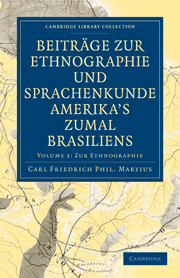Book contents
- Frontmatter
- Vorrede
- Contents
- I Die Vergangenheit und Zukunft der amerikanischen Menschheit
- II Von dem Rechtszustande unter den Ureinwohnern Brasiliens
- III Die indianischen Völkerschaften, Stämme und Horden in Brasilien und einigen benachbarten Gebieten, Land und Leute
- Das Volk der Tupi, Tupis, Tupinambá, Tupinambazes, Guarani oder Cari
- Die Indianer Brasiliens, die nicht zum Tupistamme gehören
- Indianer in den Provinzen Pará und Alto Amazonas nördlich vom Amazonenstrome
- Schlussbetrachtung
- Index
- Druckfehler und Zusätze
- Plate section
Schlussbetrachtung
Published online by Cambridge University Press: 29 August 2010
- Frontmatter
- Vorrede
- Contents
- I Die Vergangenheit und Zukunft der amerikanischen Menschheit
- II Von dem Rechtszustande unter den Ureinwohnern Brasiliens
- III Die indianischen Völkerschaften, Stämme und Horden in Brasilien und einigen benachbarten Gebieten, Land und Leute
- Das Volk der Tupi, Tupis, Tupinambá, Tupinambazes, Guarani oder Cari
- Die Indianer Brasiliens, die nicht zum Tupistamme gehören
- Indianer in den Provinzen Pará und Alto Amazonas nördlich vom Amazonenstrome
- Schlussbetrachtung
- Index
- Druckfehler und Zusätze
- Plate section
Summary
Unsere Rundschau über einen grossen Theil des südamerikanischen Continentes hat uns überall dasselbe Schauspiel vorgeführt: überall die Autochthonen, wofern sich nicht europäischer Einfluss geltend gemacht, auf einer Culturstufe, so niedrig, dass wir uns in die Periode der Steinzeit versetzt sehen, die Europa schon seit Jahrtausenden überwunden hat.
In den Wäldern und auf den Fluren, auf den Flüssen und an den Küsten des Welttheils nichts als ein unruhiges Durcheinandertreiben vielzüngiger Horden, ein regelloses Gewimmel ohne historischen Völkerbau.
Uralt ist diese amerikanische Menschheit. Sie hat hier wahrscheinlich schon gleichzeitig gelebt mit jetzt ausgestorbenen Thier geschlechtern; vielleicht da Wasser und Festland noch andere Contouren zeichneten. Monoton schwankt das Leben culturloser Wilden zwischen der Befriedigung einfachster Bedürfnisse und rohester Leidenschaften hin und her.
Wohin immer der Europäer in diese ausgedehnten Landschaften gekommen ist, nirgends ragt ihm ein Menschenwerk entgegen, das sich die Beständigkeit der Elemente zu Nutz gemacht hätten; kein Mauerwerk erhebt sich als Ueberrest einer früheren Cultur. Nur zerstreut und spärlich bezeugen rohe, unförmliche Sculpturen auf Felsen, dass Menschen hier gelebt, deren Gebeine die Zeit schon längst vor dem verwitterten Gesteine aufgelöst hat.
Kein Horizont historischer Erinnerungen begrenzt das umrisslose Getriebe zahlloser Gemeinschaften, die seit unvordenklicher Zeit Wohnort, Zahl und Sprache gewechselt haben. Nur hie und da werfen theogonische und kosmogonische My then wie fernes Wetterleuchten ein zweideutiges Licht auf das Nebelmeer einer fluctuirenden Bevölkerung ohne Mittelpunkt, ohne gemeinsamen Namen und ohne bestimmte Grenzen.
- Type
- Chapter
- Information
- Beiträge zur Ethnographie und Sprachenkunde Amerika's zumal Brasiliens1. Zur Ethnographie, pp. 763 - 782Publisher: Cambridge University PressPrint publication year: 2009First published in: 1867



